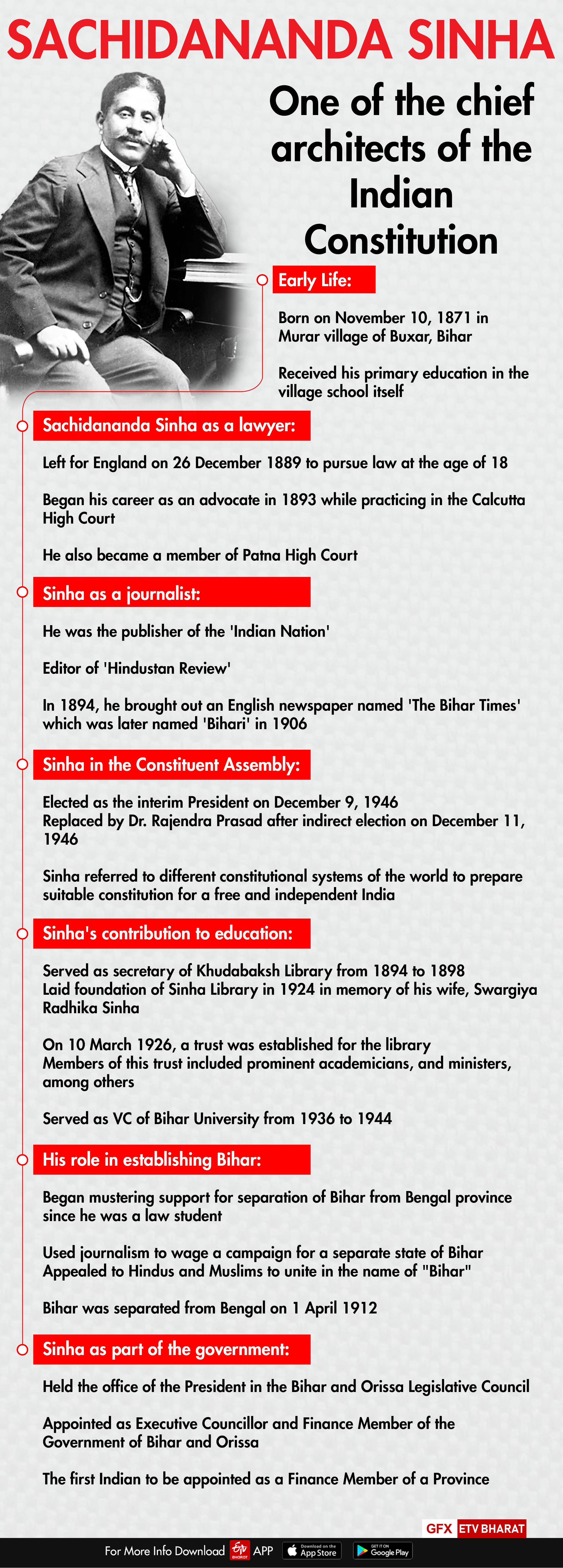Patna (Bihar): Our country's history is dynamic and is a cumulation of known and unknown events that started with the formation of the Constituent Assembly on December 9, 1946.
Not many of us know that before Dr. Rajendra Prasad was elected as the President, Dr. Sachchidananda Sinha was elected as the interim President of the Assembly by the then Congress President Acharya J.B. Kripalani. Sinha was named the Interim President of the Constituent Assembly of India on 9 December 1946 and was replaced by Dr. Rajendra Prasad after the indirect election on 11 December 1946.
Early Life
Dr. Sachchidananda Sinha was born on 10 November 1871 in Maharishi Vishwamitra's Murar village of Buxar. Dr. Sinha's father Bakshi Shiv Prasad Sinha was the Chief Tehsildar of Dumraon Maharaj. Dr. Sinha's primary education was done in the village school. On 26 December 1889, at the age of eighteen, he went to England to study law.
Sinha began his career as an advocate in 1893 practicing in the Calcutta High Court. After that, he practiced advocacy for ten years in Allahabad High Court. Meanwhile, he also edited Indian People's and Hindustan Review newspapers for many years.
Sinha as the Interim President of the Assembly
In 1946, the British Parliament announced the independence of India. On 9 December 1946, elected representatives from every region of the country gathered at the Constitution Hall in Delhi. Most of them were freedom fighters.

When the Constituent Assembly sat, the then Congress President Acharya JB Kripalani proposed the name of Dr. Sachchidananda Sinha for the position of interim President and after a consensus was reached Sinha was elected as the Interim President.
After reading out messages of goodwill received from the responsible State Officials of America, China and the Government of Australia, Sinha referred to different constitutional systems of the world and their features in the interest of preparing a suitable constitution for a free and independent India.
Khudabaksh library
Sachchidanand Sinha met Justice Khuda Bakhsh Khan in 1894 and joined him during his practicing in the Allahabad High Court. A man from Chapra, Khuda Bakhsh established his Library in Patna on 29 October 1891, which is one of the oldest libraries in India.
When Justice Khan was transferred to the High Court of Nizam in Hyderabad, Sinha took the responsibility of the Library and from 1894 to 1898, he performed his responsibility as the secretary of the Khudabakhsh Library.
Separating Bihar from Bengal
Sachchidanand Sinha played an important role in separating Bihar from Bengal. For this, he made journalism his biggest weapon. In those days there was only The Bihar Herald newspaper, whose editor was Guru Prasad Sen.
In 1894, Sachchidananda Sinha brought out an English newspaper named 'The Bihar Times' which after 1906 changed to 'Bihari'. Sachchidanand Sinha was the editor of this newspaper with Mahesh Narayan for many years. Through this newspaper, he waged a campaign for a separate state of Bihar.
He appealed to Hindus and Muslims to unite in the name of "Bihar". After his constant efforts, Bihar was separated from Bengal on 19 July 1905.
Sinha Library
Dr. Sachchidanand Sinha laid the foundation of the Sinha Library in 1924 in memory of his wife, Swargiya Radhika Sinha. It was established by Dr. Sinha for the mental, intellectual and educational development of the people.
On 10 March 1926, a trust was also established for the running of the library. Among the members of this trust, Honorable Chief Justice, Chief Minister, Education Minister, Vice-Chancellor of Patna University and many other dignitaries of that time were made lifetime members. Sanjay Kumar, a library worker, said, "Dr. Saheb wanted to go to London barrister.
But his parents did not want to send him so far. But he went to London after insisting. Following his return from London, Sinha began a movement for a separate province of Bihar with a small group of others."
The end of an era
Sinha took his last breath on 6 March 1950, in Patna, Bihar, after suffering from old age dropsy for some time past. President Dr. Rajendra Prasad unveiled the portrait of Dr. Sinha and his wife late Smt. Radhika Sinha a few days before his death and called upon him twice during his three-day visit to Patna.
Later while paying tributes, President Prasad said that Dr. Sinha was "an intellectual giant and the father of modern Bihar."
Social worker Anish Ankur said due to Dr. Sachchidanand Sinha, separate Bihar came into existence. Journalist and writer Arun Singh said that it was due to the scholarly wisdom of Dr. Sachchidanand Sinha that he was elected as the President of the Constituent Assembly and he played an important role in framing the Constitution.
He was one of the vice-chancellors of Patna University and held the post from 1936 to 1944. He also held the office of the President in the Bihar and Orissa Legislative Council. He was appointed Executive Councillor and Finance Member of the Government of Bihar and Orissa, and, thus, was the first Indian who was ever appointed as a Finance Member of a Province.
Also read: BJP's Candidate Jay Prakash Majumdar Heckled, CEO Seeks Report



